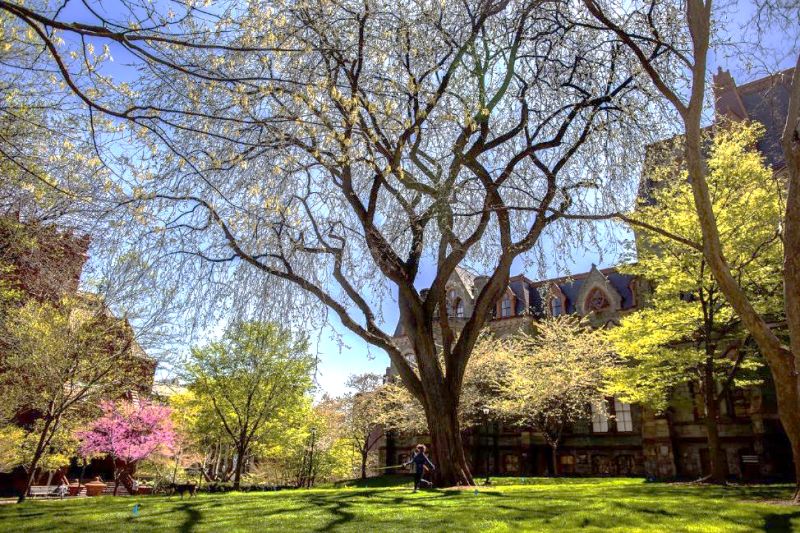Blog

Penn Treaty Elm’s Lightning Protection System Gets an Upgrade
Morris Arboretum & Gardens Urban Forestry Consulting team helps manage the approximately 6,500 trees on the University of Pennsylvania campus in the heart of West Philadelphia. While there are many great trees on campus, the Treaty Elm is undoubtedly the biggest. For this large, mature tree with a wealth of cultural and historical significance, we employ a plethora of strategies to protect and maintain its biological health and structural stability.

One feature of its defensive gauntlet is a lightning protection system. As per American National Standards Institute (ANSI) A300 Tree Care and industry best-management practices, the Treaty Elm lightning protection system consists of a conducting copper wire that begins in the upper tree canopy and is attached to the trunk/scaffold limbs all the way down to where it is grounded in the soil below.
Due to the Treaty Elm’s prominent location, accessibility to people, and rightful popularity, the staples that attached the lightning protection conductor to its trunk were frequently being pulled out, even after they were hammered back in. These detachments could potentially disconnect the copper wire conductor from the ground, compromising its effectiveness. Also, these staples are not adjustable, so the tree will eventually overgrow and subsume the staples and copper conductor. The standard staples (Photo 3) are used by virtually everyone in the arboricultural community and, with no existing alternatives, we had to come up with a more secure solution.
Initially, we developed a system that enclosed the lightning conductor within a 3/4 inch diameter gray schedule 40 PVC conduit, which was secured to the tree by a stainless steel conduit holder and screw that could be backed out as the trunk radially expanded and grew (Figure 1). However, even after we camouflaged the conduit’s color with spray paint (red arrow, Photo 2), this system’s aesthetics was not approved by Penn’s decision-makers.

After many months of discussion and trial and error, Jason Lubar, Associate Director of Urban Forestry, developed a sturdier, adjustable, more sustainable replacement to the usual brass lightning conductor staples that had been problematic. This new system, dubbed the Morris Lightning Protection Attachment, consists of three parts: a stainless steel screw, insulated rubber clamp, and small diameter PVC separator. (Photos 3 and 4).

The gray conduit blends in enough so as not to be conspicuous, the rubber clamp secures and insulates the copper conducting wire, and the stainless steel screw can be backed out periodically as the tree grows. The adjustability aligns nicely with the need for arborists to periodically inspect lightning protection systems. So far, this small but innovative contraption has ensured a more resilient lightning protection for the Treaty Elm and the trees at the Morris’s Out-on-a-Limb exhibit.

SYSTEM COMPONENTS
Clamp
- Harger CC5 5/16 inch Cable Clamp Stainless Steel Grommet
- UPC: 80847500796
- Clamp about $1.30 each
Screw
- Stainless steel 4-inch screw
- Screw about 60 cents each
Conduit
- ¾-inch water supply conduit.
- Conduit comes in a roll and is about $15. Since you are only using about 1 inch for each screw, the roll lasts a long time.
In contrast, a regular brass staple is about $4.
PROS OF THE MORRIS LP ATTACHMENT SYSTEM
- Cheaper
- Can be easily backed out
- Vandal- and child-resistant
- Visually unobtrusive
POTENTIAL WEAKNESSES OF THE MORRIS LP ATTACHMENT SYSTEM
- Need specific tools (drill/driver) for installation
- Rubber grommet and PVC collar may not be UV-resistant
- If not periodically backed out, system will get subsumed by tree growth